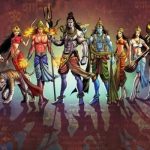In Hinduism the divine may be viewed as having form (murti) and attributes (gunas) or being without any form or qualities at all (nirguna). The former perspective was for those with little understanding and in need of every hint possible. Myths about devas added shape and form to the divine mystery.
The word deva is derived from the word for light, since a deva is one who shines forth. It was said in some sacred texts that it was related to the word for play as well. The word is older than its use in the Rigveda with a parallel in ancient Persian. In Sanskrit deva referred to the gods, those beings of light that might even be seen at the sacrifice when soma (a possible hallucinogen) was drunk by the worshippers. Opposing the devas were the asuras (demons). In ancient Persian (Avestan) the terms meant the opposite: ahura referred to the “lord or lords,” and daivas to the loud, aggressive beings who did not follow truth (asha). Persian ahuras to be taken as gods (devas) in India were Varuna, lord of truth (in Sanskrit, rita) and ruler of night, and Mitra, lord of the day.
Although deva is masculine, there are also a few devis, the feminine form, in the Vedic period: Aditi, mother of universe; Ushas, dawn; Nirriti, destruction; and Vac, speech. But most were devas, who competed among themselves, as well as with the asuras, who seem to have been thought of first as their older brothers and then later as their cousins. Both competed for territory, for female companions (drawn from all kinds of beings), for shares from the sacrifices, and for praise and reverence from worshippers (humans, animals, gods, and demons).
The devas and devis occupied and, at least in the Vedic period, ruled the three worlds: heaven (svar), mid-air (bhuvas), and earth (bhur). The principal devas of heaven were Dyaus, the sky god; Varuna, lord of rita; Mitra, lord of the day; Pushan, nourisher; and Vishnu, the pervader, or three-strider. The main devas of the mid-air were Indra, lord of storm and war; Vayu, lord of wind; the Maruts, warrior lords; and Rudras, howlers and lords of killing fire. The greatest of the earthly devas were Soma, lord of the plant soma, and Agni, lord of the sacrificial fire.
The evolution of the devas was already apparent in the Rigveda. Dyaus had no real authority or role, only a faint memory of his past glory. The first triad took shape in the middle period of the Vedas, with the heightened importance of Surya, Indra, and Agni as rulers of the three domains. As the soma experience of seeing and hearing the devas began to be referred to in ancient hymns, the magical formulas of the prayers (mantras) and the science of control of the universe through the Vedic sacrifices placed the priests (brahmins) at the center of the Vedic worldview. The devas and devis multiplied, and the classifications of divine beings expanded to include more and more classes. The gods were even given a teacher, Brihaspati, the name of an ancient deva who was also known as Brahmanaspati (lord of the prayers, or lord of ritual magic).
Creation myths appeared in the middle Vedic period, as did creators and progenitors, with mind-creation, creation by division, creation by coition, and so forth. Some devas were given these roles: Pasupati (lord of the creatures; earlier one of the Rudras), Purusha (the first being or man), Brahmanda (the cosmic egg), Virat (the cosmic essence)
The sacrificial, or ritual, religion of the Brahmanical, Epic, and Puranic periods achieved order and control of the divine worlds by classification. A devotional revolution took place alongside this ritualism. Since its notion of the divine involved something higher than the devas and devis, a supreme lord of the universe, these competing notions of divinity were able to be harmonized in their literal expression. Both ritualism and devotionalism (bhakti) could accept the myths, classifications, and iconography of the devas and devis—only devo- tionalism maintained that all these divine beings were only manifestations of the one supreme lord of the universe (whether seen as Surya, Siva, Vishnu, Devi, Krishna, Rama, or others).
As the devas and devis grew from 33 to 330,000,000 the threefold classification changed many times. The 33 presiding devas were the 12 (dvadasha) adityas, the 11 (ekadasha) Rudras, the 8 (ashtha) Vasus, and the 2 Asvins. Indra was their chief. These 33 ruled over the 330,000,000 devas. One classification divided the gods and goddesses into Adityas, Visvadevatas, Vasus, Tushitas, Abhasvaras, Ani- las, Maharajikas, Sadhyas, Rudras, Vidhyadharas, and Pitri-devas.
Further divisions added Apsaras, Virupakshas, Bhadras, Kinnaras, Gandhar- vas, Kumbhandas, Rakshasas, Nagas, Ashvinis, Kimpurushas, Pis’acas, Guhyakas, Siddhas, Caranas, Matris, Kushmandas, Bhutas, and Vetalas. Later Puranic classifications even included Lokapalas, Lipikas, Rishis, and Prajapatis as devas and devis.
The devas could be classified with reference to Bhutaganas like Prithvi or different types of devatas such as the Bhudevatas, Agnidevatas, Vayudevatas, and so on. Kubera was the presiding spirit of the Bhudevatas, Varuna of the Jaladevatas, Vayubhagavan of the Agnidevatas, and Indra of the Akashadevatas.
Hindu polytheism gave control to the ritualist; focus and loyalty to the devotionalist; a desire for unity to the philosopher or mystic; a sense of divinity in everything to naturalist, farmer, and artist—a myriad of responses to a multileveled manifestation of divinity that no one could claim to totally comprehend.

